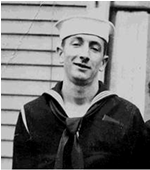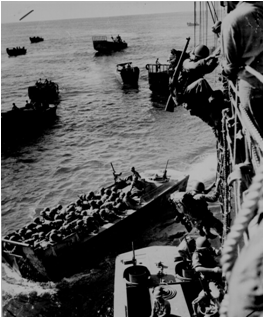Brightwood Boys, The History of the Men from
the North End of
Springfield, Massachusetts,
During World War II
by Christopher P. Montagna
CHAPTER 8 - Part 2
BATTLE OF GUADALCANAL
 On September 9, 1942, Earl "Sonny" Diamond enlisted in the Navy. At the time of his enlistment, Earl was living at 46 Allendale Street. Earl was one of thirteen children born to Patrick and Lindy Diamond. Sonny underwent basic training at the Naval Training Station in Newport, RI. After basic training he was transferred to the Receiving Station at the Philadelphia (PA) Navy Yard and assigned to the USS Denver (CL58), a light cruiser of the Cleveland Class.
On September 9, 1942, Earl "Sonny" Diamond enlisted in the Navy. At the time of his enlistment, Earl was living at 46 Allendale Street. Earl was one of thirteen children born to Patrick and Lindy Diamond. Sonny underwent basic training at the Naval Training Station in Newport, RI. After basic training he was transferred to the Receiving Station at the Philadelphia (PA) Navy Yard and assigned to the USS Denver (CL58), a light cruiser of the Cleveland Class.
On the Island of Guadalcanal, Marine Corps reinforce-ments landed 4,200 reinforcements from the 7th Marines on Guadalcanal on September 18, 1942. Among those landing was a corporal with Company K, 3rd Battalion, 7th Marine (3/7) 1st Marine Division named William (Billy) Wright. Billy would marry Adam Montagna's future sister-in-law Mildred Garlick.
Mildred Garlick was one of six children living at 45 Bancroft Street with their mother Rena (Whiteman) Garlick. The other children were: Ellen, Mary Margret, Robert, Arthur, and Frances (who married Adam Montagna). Their daughter Ethel died at two-years-old due to complications from the flu.
Rena's husband Arthur Garlick passed away in October of 1936. Arthur Garlick was an Army Veteran who, with the outbreak of the Spanish-American War, enlisted in the U.S. Army as a private with Company "F" of the 42nd Infantry on Oct. 21, 1899. While serving in the Philippines, Arthur engaged in the expedition from La Lama, P.I. to Santa Craze on Jan. 20, 1900 to Feb. 24, 1900. He also fought in three skirmishes; one near San Antonio on Feb.23, 1900; one near Pauqil on Feb. 15,1900; and Lumberg, P.I. on Feb.13, 1900. Arthur's unit was also involved in one engagement on May 30, 1900. Arthur received an honorable discharge on June 30, 1901 with the mustering out of his regiment.
Arthur was employed as a laborer until the outbreak of the First World War, at which time he re-enlisted in the army, this time as a private with Company "I" of the 48th Infantry on Jan. 12, 1917. He held the rank of Corporal from May 13, 1917 to Oct. 29, 1918. Arthur became ill and on January 15, 1919 he was discharged due to his physical condition at U.S. General Hospital #30-Plattsburg Barracks, NY.
Rena's brother Jack Whiteman began his active service on September 19, 1942. After basic training he was assigned to the 204th Quartermaster CAR Company. On February 8, 1943, Jack departed aboard a troopship and arrived in Algeria on February 25, 1943. While with the 204th QM he served as a staff chauffer with the Allied Forces Headquarters (AFHQ) in the Mediterranean Theater of Operations. The AFHQ controlled all Allied operational forces in the Mediterranean Theater of Operations from late 1942 to the end of the war and oversaw the Allied invasion of Sicily, and the Allied invasion of the Italian mainland. Jack's service included the Rome-Arno Campaign, which involved the engagements at Casino and Anzio.
William (Billy) Wright enlisted in the Marine Corps in September 1940. After boot camp at Parris Island, he was stationed with Company K, 3rd Battalion, 7th Marine (3/7). Billy served with the 3/7 at Guantanamo Bay, Cuba, from December 18, 1940 through April 11, 1941. In April 1941 the 3/7 moved to Paris Island, South Carolina. Billy and the men of the 3/7 transferred to the Pacific Theater of Operations on April 13, 1942. From August 14-30, 1942 Billy participated in the defense of Western Samoa.
On September 18, 1942, Billy Wright was one of 4,200 reinforcements from the 7th Marines to land on Guadalcanal and began to engage the well supplied enemy forces. The Marines on Guadalcanal endured repeated raids as the Japanese Navy landed troops on the island.
 On October 1, 1942, another Brightwood Boy joined the fight when Edmund Olbrych enlisted in the Marine Corps. Prior to joining the Marine Corps, Edmund was living at 57 Greenwich Street and working as a grinder at the Moore Drop Forge Company. Edmund was one of five children of Michael and Sallie Olbrych. His brother Chester Olbrych had enlisted in the Navy and was serving Stateside. After basic training Edmund Olbrych was assigned to Company L, 3rd Battalion, 23rd Marines, (3/23), 4th Marine Division and stationed at Fort Pendleton in California.
On October 1, 1942, another Brightwood Boy joined the fight when Edmund Olbrych enlisted in the Marine Corps. Prior to joining the Marine Corps, Edmund was living at 57 Greenwich Street and working as a grinder at the Moore Drop Forge Company. Edmund was one of five children of Michael and Sallie Olbrych. His brother Chester Olbrych had enlisted in the Navy and was serving Stateside. After basic training Edmund Olbrych was assigned to Company L, 3rd Battalion, 23rd Marines, (3/23), 4th Marine Division and stationed at Fort Pendleton in California.
Back on Guadalcanal, the battle continued for Nino Montagna and Billy Wright. On the night of October 11-12, 1942, Japanese battleships bombed Henderson Field with nearly 1,000 14-inch shells. Nino Montagna and the other Marines sought cover in the bomb shelters the engineers helped construct. The bombing was the most intense  single bombardment American forces had ever endured. The Marines defending Henderson Field would face one more major attack against the airfield but that attack would be repelled by the defenders.
single bombardment American forces had ever endured. The Marines defending Henderson Field would face one more major attack against the airfield but that attack would be repelled by the defenders.
Due to the Japanese Navy's attack on U.S. supply ships, the only food supplies on Guadalcanal were stores of Japanese rice. The rice, often infested with weevils, was served to the Marines at night. As Billy Wright told the story, one day the rice ration was not prepared until after daybreak. When Billy looked in his mess kit he saw the weevils swimming in the rice. This event led to Billy's lifelong dislike for rice.
 While the stalemate on Guadalcanal continued, the Marines launched another island invasion. On November 1, 1943 the 3rd Marine Division landed at Empress Augusta Bay, on the pacific island of Bougainville. Faced with heavy surf and gunfire from the defending Japanese forces, the Marines established a beachhead. The difficulties faced in the initial landing resulted in confusion and scattering of the Marines. Once ashore, the dense jungle terrain posed another obstacle to reorganizing the scattered troops.
While the stalemate on Guadalcanal continued, the Marines launched another island invasion. On November 1, 1943 the 3rd Marine Division landed at Empress Augusta Bay, on the pacific island of Bougainville. Faced with heavy surf and gunfire from the defending Japanese forces, the Marines established a beachhead. The difficulties faced in the initial landing resulted in confusion and scattering of the Marines. Once ashore, the dense jungle terrain posed another obstacle to reorganizing the scattered troops.
Photo: U.S. troops go over the side of a Coast Guard manned combat transport to enter the landing barges at Empress Augusta Bay, Bougainville, as the invasion gets under way.